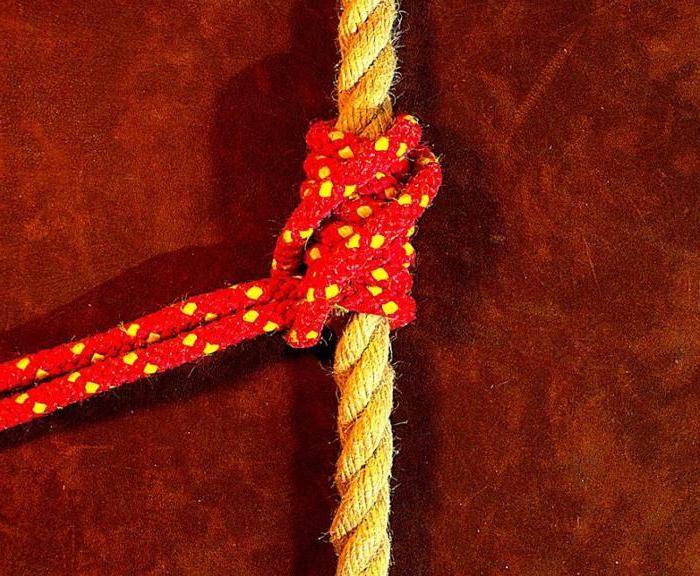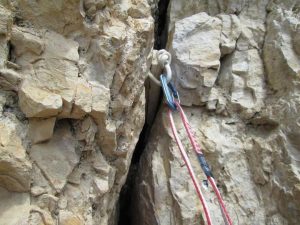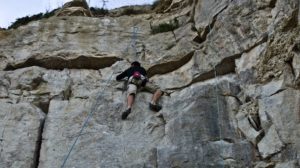The Klemheist knot, like a Prusik knot, is a friction knot or slide-and-grip hitch that is tied around a climbing rope with a thin length of cord. When a climber loads his weight onto the knot, it tightens and cinches onto the rope.
Klemheist knots are used in pairs to ascend a fixed rope by sliding the knots up the rope. Since the Klemheist is not symmetrical like a Prusik knot, it is only useful for going one way on a rope.
Klemheist Knot is Easy to Tie
It’s very important to learn this friction knot so if you have to do a self-rescue, you will be able to do it and won’t be floundering at the end of your rope. The Klemheist knot is easy to tie and with a bit of practice, you can tie it with one hand.
The Klemheist knot is superior to a Prusik knot because, unlike the Prusik, it is easy to loosen up after being weighted. It also can be tied with slings or webbing rather than just a cord, making it ideal to use if you’re not carrying Prusik slings.
Step 1: How to Tie a Klemheist Knot
To tie a Klemheist knot you need “Prusik slings,” which are two lengths of thin cord (preferably 5mm or 6mm in diameter). The thinner the cord is in relation to the thickness of the climbing rope, the greater the ability of the knot to grab the rope. It’s best to make the Prusik slings about two feet long, although some climbers like having one of the slings as long as four or five feet.
Buy a five-foot length of thin nylon cord that is specifically made for climbing. Avoid buying spectra cord since it can melt if the knot slips. Tie the ends together with a double fisherman’s knot, forming a closed loop.
First Step to Tie a Klemheist Knot
The first step to tie a Klemheist knot is to take the loop of the cord and place it behind the main climbing rope. Then, after leaving an open loop about 4 inches long at the top and with the knot in the cord at the bottom, wrap the cord around the rope four or five times. Keep the wraps neat and tidy.
Second Step to Tie a Klemheist Knot
The second step to tie a Klemheist knot, after you’ve wrapped the Prusik sling around the climbing rope four or five times, is to take the bottom tail of the sling (the end with the knot) and pass it up through the open loop at the top of the knot. Tighten down and dress the knot by neatly arranging the wraps. Now clip a carabiner into the bottom open loop and test it.
If it slips, add another wrap. If it doesn’t, you’re ready to go.
The Klemheist knot also called a Machard knot, is usually used by climbers in emergency situations when it is necessary to ascend a fixed rope, either to lend aid to an injured climber, to rescue yourself after falling on an overhanging face, or to self-evacuate after falling into a crevasse.
Escaping the Belay
The Klemheist knot is also good for tying off an injured climber’s rope and escaping the belay to seek help.
Remember always to tie the rope into the belay after you’ve escaped. Practice tying the knot until you can tie it with one hand. This skill is useful if you’re hanging below an overhang or using one hand to hold a climber’s weight with your belay device after he’s fallen.
Best Ascending Knot
Klemheist knots really shine if you need to ascend a fixed rope. While most climbers use mechanical ascenders to climb a rope, Klemheist knots are a good substitute. If you’re going to ascend a rope, you’ll need to tie two knots on the rope and use them in tandem with one for the right hand and one for the left. The sling from the top knot is clipped directly into your harness’s belay loop. The sling from the bottom knot is clipped to a sling for a foot loop. Some prefer clipping both slings to their harness so they’re tied into both knots and using separate foot slings for each foot.
How to Prusik
To ascend the rope with knots is called Prusikking. Before you try this in an emergency, practice so you’re familiar with the motion because it isn’t as easy as it looks!
The basic technique is to weigh the bottom knot by standing in the foot sling. Then slide the barrel of the upper knot (clipped to your harness) up the rope until it’s taut. Now sit in your harness, weigh the top knot, and slide the lower knot up. Repeat the motion and you’re golden. Again, practice, and then you’ll know how to tie and use the Klemheist knot.













